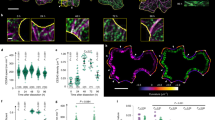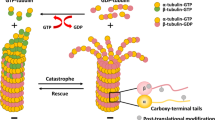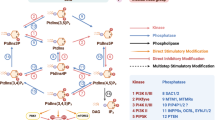Abstract
Programmed cell death (PCD) involves precise integration of cellular responses to extracellular and intracellular signals during both stress and development. In recent years much progress in our understanding of the components involved in PCD in plants has been made. Signalling to PCD results in major reorganisation of cellular components. The plant cytoskeleton is known to play a major role in cellular organisation, and reorganization and alterations in its dynamics is a well known consequence of signalling. There are considerable data that the plant cytoskeleton is reorganised in response to PCD, with remodelling of both microtubules and microfilaments taking place. In the majority of cases, the microtubule network depolymerises, whereas remodelling of microfilaments can follow two scenarios, either being depolymerised and then forming stable foci, or forming distinct bundles and then depolymerising. Evidence is accumulating that demonstrate that these cytoskeletal alterations are not just a consequence of signals mediating PCD, but that they also may have an active role in the initiation and regulation of PCD. Here we review key data from higher plant model systems on the roles of the actin filaments and microtubules during PCD and discuss proteins potentially implicated in regulating these alterations.
Similar content being viewed by others
Log in or create a free account to read this content
Gain free access to this article, as well as selected content from this journal and more on nature.com
or
Abbreviations
- ABP:
-
actin-binding protein
- ADF:
-
actin-depolymerising factor
- CAP:
-
cyclase-associated protein
- F-actin:
-
filamentous actin
- HR:
-
hypersensitive response
- MAP:
-
microtubule-associated protein
- PCD:
-
programmed cell death
- SI:
-
self-incompatibility
References
Smertenko AP, Deeks MJ, Hussey PJ . Strategies of actin reorganisation in plant cells. J Cell Sci 2010; 123: 3019–3029.
Staiger CJ, Poulter NS, Henty JL, Franklin-Tong VE, Blanchoin L . Regulation of actin dynamics by actin-binding proteins in pollen. J Exp Bot 2010; 61: 1969–1986.
Shaw SL, Kamyar R, Ehrhardt DW . Sustained microtubule treadmilling in Arabidopsis cortical arrays. Science 2003; 300: 1715–1718.
Hamada T . Microtubule-associated proteins in higher plants. J Plant Res 2007; 120: 79–98.
Sedbrook JC . MAPs in plant cells: delineating microtubule growth dynamics and organization. Cur Opin Plant Biol 2004; 7: 632–640.
Staiger CJ (ed.). Actin: A dynamic framework for multiple plant cell functions. Kluwer Academic Publishers: Dordrecht, The Netherlands, 2000.
Fukuda H, Kobayashi H . Dynamic organization of the cytoskeleton during tracheary-element differentiation. Dev Growth Differ 1989; 31: 9–16.
Oda Y, Hasezawa S . Cytoskeletal organization during xylem cell differentiation. J Plant Res 2006; 119: 167–177.
Kobayashi H, Fukuda H, Shibaoka H . Interrelation between the spatial disposition of actin-filaments and microtubules during the differentiation of tracheary elements in cultured zinnia cells. Protoplasma 1988; 143: 29–37.
Oda Y, Mimura T, Hasezawa S . Regulation of secondary cell wall development by cortical microtubules during tracheary element differentiation in Arabidopsis cell suspensions. Plant Phys 2005; 137: 1027–1036.
Bozhkov PV, Filonova LG, Suarez MF . Programmed cell death in plant embryogenesis. Curr Topics Plant Dev 2005; 67: 135–179.
Smertenko AP, Bozhkov V, Filonova LH, von Arnold S, Hussey PJ . Re-organisation of the cytoskeleton during developmental programmed cell death in Picea abies embryos. Plant J 2003; 33: 813–824.
Schwarzerova K, Vondrakova Z, Fischer L, Borikova P, Bellinvia E, Eliasova K et al. The role of actin isoforms in somatic embryogenesis in Norway spruce. BMC Plant Biol 2010; 10: 89.
Swidzinski JA, Sweetlove LJ, Leaver CJ . A custom microarray analysis of gene expression during programmed cell death in Arabidopsis thaliana. Plant J 2002; 30: 431–446.
Bai SY, Willard B, Chapin LJ, Kinter MT, Francis DM, Stead AD et al. Proteomic analysis of pollination-induced corolla senescence in petunia. J Exp Bot 2010; 61: 1089–1109.
Keech O, Pesquet E, Gutierrez L, Ahad A, Bellini C, Smith S et al. Leaf senescence is accompanied by an early disruption of the microtubule network in Arabidopsis. Plant Phys 2010; 154: 1710–1720.
McClure B, Franklin-Tong V . Gametophytic self-incompatibility: understanding the cellular mechanisms involved in ‘self’ pollen tube inhibition. Planta 2006; 224: 233–245.
Foote HCC, Ride JP, Franklin-Tong VE, Walker EA, Lawrence MJ, Franklin FCH . Cloning and expression of a distinctive class of self- incompatibility (S) gene from Papaver rhoeas L. Proc Nat Acad Scie USA 1994; 91: 2265–2269.
Wheeler MJ, de Graaf BHJ, Hadjiosif N, Perry RM, Poulter NS, Osman K et al. Identification of the pollen self-incompatibility determinant in Papaver rhoeas. Nature 2009; 459: 992–995.
Thomas SG, Franklin-Tong VE . Self-incompatibility triggers programmed cell death in Papaver pollen. Nature 2004; 429: 305–309.
Bosch M, Franklin-Tong VE . Temporal and spatial activation of caspase-like enzymes induced by self-incompatibility in Papaver pollen. Proc Natl Acad Sci USA 2007; 104: 18327–18332.
Bosch M, Franklin-Tong VE . Self-incompatibility in Papaver: signalling to trigger PCD in incompatible pollen. J Exp Bot 2008; 59: 481–490.
Wilkins KA, Bancroft J, Bosch M, Ings J, Smirnoff N, Franklin-Tong VE et al. ROS and NO are involved in the self-incompatibility response of Papaver. Plant Physiology; doi 10.1104/pp.110.167510.
Li S, Samaj J, Franklin-Tong VE . A mitogen-activated protein kinase signals to programmed cell death induced by self-incompatibility inPapaver pollen. Plant Physiol 2007; 145: 236–245.
Geitmann A, Franklin-Tong VE, Emons AMC . The self-incompatibility response in Papaver rhoeas pollen causes early and striking alterations to organelles. Cell Death Differ 2004; 11: 812–822.
Jordan ND, Franklin FCH, Franklin-Tong VE . Evidence for DNA fragmentation triggered in the self- incompatibility response in pollen of Papaver rhoeas. Plant J 2000; 23: 471–479.
Geitmann AB, Snowman BN, Emons AMC, Franklin-Tong VE . Alterations in the actin cytoskeleton of pollen tubes are induced by the self-incompatibility reaction in Papaver rhoeas. Plant Cell 2000; 12: 1239–1252.
Snowman BN, Kovar DR, Shevchenko G, Franklin-Tong VE, Staiger CJ . Signal-mediated depolymerization of actin in pollen during the self-incompatibility response. Plant Cell 2002; 14: 2613–2626.
Poulter NS, Staiger CJ, Rappoport JZ, Franklin-Tong VE . Actin-binding proteins implicated in formation of the punctate actin foci stimulated by the self-incompatibility response in Papaver. Plant Physiol 2010; 152: 1274–1283.
Poulter NS, Bosch M, Franklin-Tong VE . Proteins implicated in mediating Self-Incompatibility-induced alterations to the actin cytoskeleton of Papaver pollen. Ann Bot 2011; doi: 10.1093/aob/mcr022.
Poulter NS, Vatovec S, Franklin-Tong VE . Microtubules are a target for self-incompatibility signaling in Papaver pollen. Plant Physiol 2008; 146: 1358–1367.
Wang CL, Xu GH, Jiang XT, Chen G, Wu J, Wu HQ et al. S-RNase triggers mitochondrial alteration and DNA degradation in the incompatible pollen tube of Pyrus pyrifolia in vitro. Plant J 2009; 57: 220–229.
Liu ZQ, Xu GH, Zhang SL . Pyrus pyrifolia stylar S-RNase induces alterations in the actin cytoskeleton in self-pollen and tubes in vitro. Protoplasma 2007; 232: 61–67.
Wang CL, Wu J, Xu GH, Gao YB, Chen G, Wu JY et al. S-RNase disrupts tip-localized reactive oxygen species and induces nuclear DNA degradation in incompatible pollen tubes of Pyrus pyrifolia. J Cell Sci 2010; 123: 4301–4309.
Greenberg JT . Programmed cell death: a way of life for plants. Proc Nat Acad Sci USA 1996; 93: 12094–12097.
Lam E, Kato N, Lawton M . Programmed cell death, mitochondria and the plant hypersensitive response. Nature 2001; 411: 848–853.
Greenberg JT, Yao N . The role and regulation of programmed cell death in plant-pathogen interactions. Cell Microbiol 2004; 6: 201–211.
Lam E . Controlled cell death, plant survival and development. Nat Rev Mol Cell Biol 2004; 5: 305–315.
Skalamera D, Heath MC . Changes in the cytoskeleton accompanying infection-induced nuclear movements and the hypersensitive response in plant cells invaded by rust fungi. Plant J 1998; 16: 191–200.
Takemoto D, Jones DA, Hardham AR . GFP-tagging of cell components reveals the dynamics of subcellular re-organization in response to infection of Arabidopsis by oomycete pathogens. Plant J 2003; 33: 775–792.
Higaki T, Goh T, Hayashi T, Kutsuna N, Kadota Y, Hasezawa S et al. Elicitor-induced cytoskeletal rearrangement relates to vacuolar dynamics and execution of cell death: in vivo imaging of hypersensitive cell death in tobacco BY-2 cells. Plant Cell Phys 2007; 48: 1414–1425.
Kobayashi I, Kobayashi Y, Hardham AR . Dynamic reorganization of microtubules and microfilaments in flax cells during the resistance response to flax rust infection. Planta 1994; 195: 237–247.
Takemoto D, Jones DA, Hardham AR . Re-organization of the cytoskeleton and endoplasmic reticulum in the Arabidopsis pen1-1 mutant inoculated with the non-adapted powdery mildew pathogen, Blumeria graminis f. sp hordei. Mol Plant Pathol 2006; 7: 553–563.
Cahill D, Rookes J, Michalczyk A, McDonald K, Drake A . Microtubule dynamics in compatible and incompatible interactions of soybean hypocotyl cells with Phytophthora sojae. Plant Pathol 2002; 51: 629–640.
Binet MN, Humbert C, Lecourieux D, Vantard M, Pugin A . Disruption of microtubular cytoskeleton induced by cryptogein, an elicitor of hypersensitive response in tobacco cells. Plant Physiol 2001; 125: 564–572.
Franklin-Tong VE, Gourlay CW . A role for actin in regulating apoptosis/programmed cell death: evidence spanning yeast, plants and animals. Biochem J 2008; 413: 389–404.
Thomas SG, Huang SJ, Li ST, Staiger CJ, Franklin-Tong VE . Actin depolymerization is sufficient to induce programmed cell death in self-incompatible pollen. J Cell Biol 2006; 174: 221–229.
Miklis M, Consonni C, Bhat RA, Lipka V, Schulze-Lefert P, Panstruga R . Barley mLO Modulates actin-dependent and actin-independent antifungal defense pathways at the cell periphery. Plant Physiol 2007; 144: 1132–1143.
Tomiyama K, Sato K, Doke N . Effect of cytochalasin b and colchicine on hypersensitive death of potato cells infected by incompatible race of Phytophthora-infestans. Ann Phytopathol Soc Japan 1982; 48: 228–230.
Takemoto D, Maeda H, Yoshioka H, Doke N, Kawakita K . Effect of cytochalasin D on defence responses of potato tuber discs treated with hyphal wall components of Phytophthora infestans. Plant Sci 1999; 141: 219–226.
Kobayashi Y, Kobayashi I . Depolymerization of the actin cytoskeleton induces defense responses in tobacco plants. J Gen Plant Pathol 2007; 73: 360–364.
Tian M, Chaudhry F, Ruzicka DR, Meagher RB, Staiger CJ, Day B . Arabidopsis actin-depolymerizing factor AtADF4 mediates defense signal transduction triggered by the Pseudomonas syringae effector AvrPphB. Plant Physiol 2009; 150: 815–824.
Schmelzer E . Cell polarization, a crucial process in fungal defence. Trends Plant Sci 2002; 7: 411–415.
Maciver SK, Hussey PJ . The ADF/cofilin family: actin-remodeling proteins. Genome Biol 2002; 3: 3007.1–3007.12.
Smertenko AP, Jiang CJ, Simmons NJ, Weeds AG, Davies DR, Hussey PJ . Ser6 in the maize actin-depolymerizing factor, ZmADF3, is phosphorylated by a calcium-stimulated protein kinase and is essential for the control of functional activity. Plant J 1998; 14: 187–194.
Huang S, Blanchoin L, Chaudhry F, Franklin-Tong VE, Staiger CJ . A gelsolin-like protein from Papaver rhoeas pollen (PrABP80) stimulates calcium-regulated severing and depolymerization of actin filaments. J Biol Chem 2004; 279: 23364–23375.
Lila T, Drubin DG . Evidence for physical and functional interactions among two Saccharomyces cerevisiae SH3 domain proteins, an adenylyl cyclase-associated protein and the actin cytoskeleton. Mol Biol Cell 1997; 8: 367–385.
Sagot I, Pinson B, Salin B, Daignan-Fornier B . Actin bodies in yeast quiescent cells: an immediately available actin reserve? Mol Biol Cell 2006; 17: 4645–4655.
Gourlay CW, Carpp LN, Timpson P, Winder SJ, Ayscough KR . A role for the actin cytoskeleton in cell death and aging in yeast. J Cell Biol 2004; 164: 803–809.
McLusky SR, Bennett MH, Beale MH, Lewis MJ, Gaskin P, Mansfield JW . Cell wall alterations and localized accumulation of feruloyl-3′-methoxytyramine in onion epidermis at sites of attempted penetration by Botrytisallii are associated with actin polarisation, peroxidase activity and suppression of flavonoid biosynthesis. Plant J 1999; 17: 523–534.
Shimada C, Lipka V, O’Connell R, Okuno T, Schulze-Lefert P, Takano Y . Nonhost resistance in Arabidopsis-Colletotrichum interactions acts at the cell periphery and requires actin filament function. Mol Plant Microbe Inter 2006; 19: 270–279.
Shan XC, Goodwin PH . Reorganization of filamentous actin in Nicotiana benthamiana leaf epidermal cells inoculated with Colletotrichum destructivum and Colletotrichum graminicola. Int J Plant Sci 2005; 166: 31–39.
Barton DA, Vantard M, Overall RL . Analysis of cortical arrays from Tradescantia virginiana at high resolution reveals discrete microtubule subpopulations and demonstrates that confocal images of arrays can be misleading. Plant Cell 2008; 20: 982–994.
Chan J, Jensen CG, Jensen LC, Bush M, Lloyd CW . The 65-kDa carrot microtubule-associated protein forms regularly arranged filamentous cross-bridges between microtubules. Proc Natl Acad Sci USA 1999; 96: 14931–14936.
Hao S, August A . Actin depolymerization transduces the strength of B-cell receptor stimulation. Mol Biol Cell 2005; 16: 2275–2284.
Shi F-M, Yao L-L, Pei B-L, Zhou Q, Li X-L, Li Y et al. Cortical microtubule as a sensor and target of nitric oxide signal during the defence responses to Verticillium dahliae toxins in Arabidopsis. Plant Cell Evir 2009; 32: 428–438.
Acknowledgements
Work in the lab of VE F-T. is funded by the Biotechnology and Biological Sciences Research Council (B.B.S.R.C.).
Author information
Authors and Affiliations
Corresponding author
Ethics declarations
Competing interests
The authors declare no conflict of interest.
Additional information
Edited by P Bozhkov
Rights and permissions
About this article
Cite this article
Smertenko, A., Franklin-Tong, V. Organisation and regulation of the cytoskeleton in plant programmed cell death. Cell Death Differ 18, 1263–1270 (2011). https://doi.org/10.1038/cdd.2011.39
Received:
Revised:
Accepted:
Published:
Issue date:
DOI: https://doi.org/10.1038/cdd.2011.39
Keywords
This article is cited by
-
Cell type matters: competence for alkaloid metabolism differs in two seed-derived cell strains of Catharanthus roseus
Protoplasma (2023)
-
Switching cell fate by the actin–auxin oscillator in Taxus: cellular aspects of plant cell fermentation
Plant Cell Reports (2022)
-
MicroRNA-mediated responses to colchicine treatment in barley
Planta (2020)
-
Auxin protects Arabidopsis thaliana cell suspension cultures from programmed cell death induced by the cellulose biosynthesis inhibitors thaxtomin A and isoxaben
BMC Plant Biology (2019)
-
Differential protein profiles in interspecific hybrids between Elaeis oleifera and E. guineensis with contrasting responses to somatic embryogenesis competence acquisition
Plant Cell, Tissue and Organ Culture (PCTOC) (2019)



